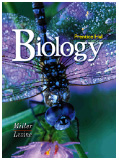BIOLOGY
by Miller & Levine
[complete Table of Contents]

|
Use the pull-down menu to jump to any of the Book's 40 Chapters: |
Additional Resources:
Is
there Life in a Desert of Ice?
Check out
this page on life at the North Pole
Cycles
of Change in the Forest
This web
page at the Oregon Museum of Science and Industry shows ecological succession
in the forests of the American Northwest
![]() Chapter 4
Chapter 4![]()
Ecosystems and Communities
In this chapter, students will read ..... The links below lead to additional resources to help you with this chapter. These include Hot Links to Web sites related to the topics in this chapter, the Take It to the Net activities referred to in your textbook, a Self-Test you can use to test your knowledge of this chapter, and Teaching Links that instructors may find useful for their students.
| Hot Links | Take it to the Net |
| Chapter Self-Test | Teaching Links |
What are Web Codes? |
Web
Codes for Chapter 4: Active Art: Earth's Biomes SciLinks: Climate and the Greenhouse Effect SciLinks: Biomes SciLinks: Aquatic Ecosystems Self-Test |
![]()
Section 4-1: The Role of Climate
![]() Carbon dioxide,
methane, water vapor, and a few other atmospheric gases trap heat energy
and maintain Earth's temperature range.
Carbon dioxide,
methane, water vapor, and a few other atmospheric gases trap heat energy
and maintain Earth's temperature range.
 As a result of differences in latitude
and thus the angle of heating, Earth has three main climate zones: polar,
temperate, and tropical.
As a result of differences in latitude
and thus the angle of heating, Earth has three main climate zones: polar,
temperate, and tropical.
Section 4-2: What Shapes an Ecosystem?
 Together, biotic and abiotic factors
determine the survival and growth of an organism and the productivity
of the ecosystem in which the organism lives.
Together, biotic and abiotic factors
determine the survival and growth of an organism and the productivity
of the ecosystem in which the organism lives.
 Community interactions, such as competition,
predation, and various forms of symbiosis, can powerfully affect an ecosystem.
Community interactions, such as competition,
predation, and various forms of symbiosis, can powerfully affect an ecosystem.
 Ecosystems are constantly changing in
response to natural and human disturbances. As an ecosystem changes, older
inhabitants gradually die out and new organisms move in, causing further
changes in the community.
Ecosystems are constantly changing in
response to natural and human disturbances. As an ecosystem changes, older
inhabitants gradually die out and new organisms move in, causing further
changes in the community.
Section 4-3: Land Biomes
 The world's major land biomes include
tropical rain forest, tropical dry forest, tropical savanna, temperate
grassland, desert, temperate woodland and shrubland, temperate forest,
northwestern coniferous forest, boreal forest, and tundra. Each of these
biomes is defined by a unique set of abiotic factors—particularly
climate—and has a characteristic ecological community.
The world's major land biomes include
tropical rain forest, tropical dry forest, tropical savanna, temperate
grassland, desert, temperate woodland and shrubland, temperate forest,
northwestern coniferous forest, boreal forest, and tundra. Each of these
biomes is defined by a unique set of abiotic factors—particularly
climate—and has a characteristic ecological community.
Section 4-4: Aquatic Ecosystems
 Aquatic ecosystems are determined primarily
by the depth, flow, temperature, and chemistry of the overlying water.
Aquatic ecosystems are determined primarily
by the depth, flow, temperature, and chemistry of the overlying water.
 Freshwater ecosystems can be divided
into two main types: flowing-water ecosystems and standing-water ecosystems.
Freshwater ecosystems can be divided
into two main types: flowing-water ecosystems and standing-water ecosystems.
 In addition to the division between the
photic and aphotic zones, marine biologists also divide the ocean into
zones based on the depth and distance from shore: the intertidal zone,
coastal ocean, and the open ocean.
In addition to the division between the
photic and aphotic zones, marine biologists also divide the ocean into
zones based on the depth and distance from shore: the intertidal zone,
coastal ocean, and the open ocean.
